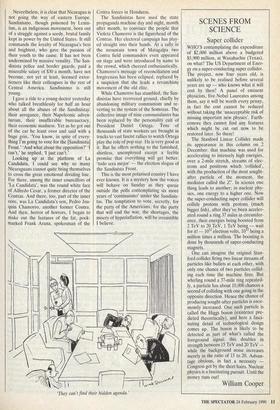SCENES FROM SCIENCE
Super collider
WHO'S contemplating the expenditure of $2,000 million above a budgeted $5,900 million, at Waxahachie (Texas), on what? The US Department of Ener- gy on a super-conducting super collider. The project, now four years old, is unlikely to be realised before several years are up — who knows what it will cost by then? A panel of eminent physicists, five Nobel Laureates among them, say it will be worth every penny, in fact the cost cannot be reduced without taking the 'unacceptable risk of missing important new physics'. Furth- ermore they cannot find any features which might be cut out now to be restored later. So there!
The Stanford Linear Collider made its appearance in this column on 2 December: that machine was used for accelerating to intensely high energies, over a 2-mile stretch, streams of elec- trons and positrons which 'collided', with the production of the most sought- after particle of the moment, the mediator called the Z°. In science one thing leads to another; in nuclear phy- sics, one energy to a higher one. Now the super-conducting super collider will collide protons with protons (much bigger fish), after they've been acceler- ated round a ring 37 miles in circumfer- ence, their energies being boosted from 2 TeV to 20 TeV, 1 TeV being.— wait for it! — 1012 electron volts, 10," being a million times a million. The boosting is done by thousands of super-conducting magnets.
One can imagine the original Stan- ford collider firing two linear Streams of particles like bullets at each other, with only one chance of two particles collid- ing each time the machine fires. But whirling round a 37-mile ring repeated- ly, a particle has about 10,000 chances a second of colliding with one going in the opposite direction. Hence the chance of producing sought-after particles is enor- mously increased. One such particle is called the Higgs boson (existence pre- dicted theoretically), and here a fasci- nating detail of technological design comes up. The boson is likely to be detected as part of what's called the foreground signal: this doubles in strength between 15 TeV and 20 TeV — while the background noise increases merely in the ratio of 15 to 20. Advan- tage obvious, in fact a necessity -- Congress got by the short hairs. Nuclear physics is a fascinating pursuit. Until the money runs out!
William Cooper


















































 Previous page
Previous page